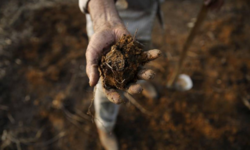
Zezito Oliveira, 83, holds earth from his farm in the village of Rio Pardo next to Bom Futuro National Forest, in the district of Porto Velho, Rondonia State, Brazil. (Photo: REUTERS/Nacho Doce)
Does the end of high food prices mark the end of the global land rush?
by by Pascal Liu | FAO
The surge in commodity prices in 2007-2008 was one of the main causes of what has sometimes been described as the “global land rush” - a wave of large-scale land acquisitions in developing countries by foreign investors. Non-governmental organisations and the media were quick to denounce these deals as “land grabbing”, which were blamed for ignoring the rights and interests of the people who make their living from a land that is legitimately theirs.
High food prices made the returns on investing in developing country farmland become attractive for agribusiness companies and financial investors seeking to diversify away from poorly performing equity and bond markets. They also spurred countries heavily dependent on food imports to invest in countries with under-utilised land to produce food for consumption back home. The peak oil prices and biofuel policies that had helped trigger the food price spike also led to an investment surge in feedstock crops for biofuel.
Almost a decade after the 2007-2008 price spike, today’s situation looks very different. Global agricultural production has risen strongly in recent years, especially for cereals, partly as a result of the investment boom. This output rise, combined with lower demand growth, has pushed real prices much below their peak levels of 2008.
The OECD and FAO project that real agricultural commodity prices will resume their long-term declining trend in the medium term, as production growth, driven by on-trend productivity growth and lower input prices, slightly outpaces slowing demand increases. At the same time, falling oil prices and the reform of biofuel policies in major industrial countries have greatly reduced the incentives for investing in feedstock crops.
It is tempting to assume that now that prices for food and oil are expected to remain relatively low, the land rush will abate. As investors respond to price signals, lower prices should logically result in lower investment. Recent developments in global flows of foreign direct investment (FDI) in agriculture seem to support this view. After reaching a peak of some $35 billion in 2009, FDI in food, beverage and tobacco decreased to around $20 billion per year in 2013-2014.
Yet, it would be wrong to conclude that investors’ interest in agriculture has vanished. While global agricultural FDI flows are lower than in the aftermath of the global food price crises of 2007-2008 and 2011-2012, they are still higher than their average level in the early 2000s. Real food prices are still higher than in the early 2000s, when they reached a record low, but this does not tell the whole story. Output prices are a major driver of agricultural investment, but not the only one. It seems that countries heavily dependent on food imports continue to invest in agricultural production abroad. Market conditions have only a limited impact on policies and strategies aimed at long-run national food security.
More importantly, even if international capital finds developing country agriculture less attractive, domestic investors may well take a different view. The land rush is usually depicted as foreign investors “grabbing” natural resources in poor countries, but domestic investors have often played a major role. Case studies by the World Bank found that they were responsible for some 80 percent of the surveyed land deals and acquired 60 percent of the related area.
Some of the factors that spurred domestic investment in agriculture are still around today. Developing country agriculture has suffered from decades of under-investment compared to what is needed to eliminate hunger. In many developing countries, the population is growing fast, becoming more affluent and urbanised and seeking a more diversified diet.
Meeting these growing food needs will require enormous investments. FAO and other U.N. agencies estimate that over $100 billion of additional investment in agriculture will be needed every year to eliminate hunger by 2030. Global warming may further increase this need, as tropical agriculture will have to adapt to a changing climate. This investment gap still gives local businesses an incentive to buy farmland. Beside these economic drivers, social and cultural factors still fuel domestic land purchases in developing countries. Owning land is often seen as a status symbol.
Even if food prices may be on a long-term declining trend, it is unlikely that “land grabbing” will disappear. “Land grabbing” is bad for local people, agricultural development and even the investor.
It should be combated decisively, in particular by the governments of the countries where it occurs, as it often reflects weak local governance. But it should not hide the truth that higher agricultural investment in developing countries is good for them and the whole world. Acquiring land is one way of investing in agriculture, but there are many other models. Investments that involve local farmers without transferring land rights are more likely to succeed.
What is most needed is helping developing country governments to promote the right forms of investment - those of farmers in their own farms above all, and other investments that benefit local farmers and their communities. In this respect, the recent launch of a global programme to support responsible investments in agriculture and food systems by FAO is good news.












